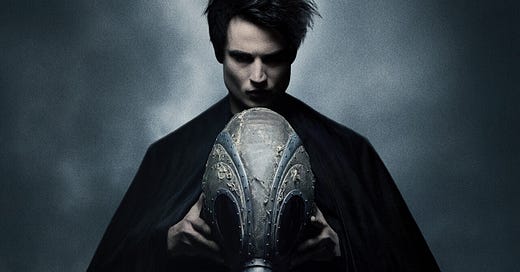Poets Watching TV: Neil Gaiman’s Knowledge of Folklore Contributes to One of The Sandman’s Best Scenes
Shapeshifting as Poetry and Other Myths
You’re reading a PopPoetry guest post by Ennis Bashe. Ennis is a queer romance novelist and poet whose work has appeared in Strange Horizons, Cricket, and Liminality Magazine. Their upcoming chapbook Beautiful Malady, about the inherent gothness of chronic illness, is scheduled for a spring 2023 release from Interstellar Press. Their self-published debut chapbook, Glitter Blood, was an Elgin Award nominee. Find them at ennisrookbashe.com or on Twitter at @rookthebird.
The Sandman Cometh
In the fourth episode of Netflix’s The Sandman, Gwendolyn Christie’s Lucifer (an enthroned monarch surrounded by loyal followers, radiating pink-cheeked good humor and health at the height of her power, 7’5” with the wings) faces off against Dream of the Endless (his domain in ruins, fresh from a century of magical imprisonment with the basement-dwelling pallor to match, weirdly twiglike in comparison at 5’10”) in a shapeshifting contest referred to as the Oldest Game.
They start out with forms like a wolf, a hunter, a snake, and a bird of prey before escalating into the metaphorical. At last, Dream becomes a universe (“all things encompassing, all life embracing,) and Lucifer becomes “anti-life, the dark at the end of everything.” It looks like Dream is going to lose, but after a pep talk from his animal companion, he counters by becoming hope.
Neil Gaiman is not one of the nostalgia-chasing catchphrase dispensers that many popular adaptations try to pass off as showrunners these days. Neil Gaiman is a poet.
Internet commenters have described the scene as a reference to Disney’s The Sword in the Stone, in which Merlin and the antagonist try to best each other by turning into different creatures, which is surprising for two reasons.
First, the construct used here was part of our cultural imagination long before a famous cartoon mouse put his gloves on. Second, Neil Gaiman is not one of the nostalgia-chasing catchphrase dispensers that many popular adaptations try to pass off as showrunners these days. Neil Gaiman is a poet. The “Oldest Game” scene is very similar to instances of the same motif in the folk imagination in both subject matter and structure, and these similarities are intentional.
It’s obvious from Gaiman’s other works that he has a significant knowledge of folklore. Just check out his widely anthologized poem, “Instructions.”
Remember: that giants sleep too soundly; that witches are often betrayed by their appetites; dragons have one soft spot, somewhere, always; hearts can be well-hidden, and you betray them with your tongue.
As readers, we don’t need to know every specific story he’s referencing in order to appreciate the poem, but it’s clear that Gaiman has read widely to be able to draw on these images.
Shapeshifting Motifs
One shapeshifting duel extant in folklore appears in the stories of the early Britonic poet Taliesin. According to the mid-16th-century Hanes Taliesin (in English, The Tale of Taliesin, which draws from the middle Welsh possibly-10th-century Llyfr Taliesin, aka The Book of Taliesin), Taliesin once had to shapeshift to escape an angry goddess. As a young boy called Gwion Bach, it was his job to cook special herbs for the goddess Ceridwen so her ugly son could gain wisdom. However, he gained wisdom instead, and Ceridwen chased him down. His ultimate strategy was to turn himself into a grain that she’d swallow so he could impregnate her in order to be reborn. (This all makes way more sense in context, TBH.) As depicted in an 1877 translation by Lady Charlotte Guest, here’s how it went:
And she went forth after him, running. And he saw her, and changed himself into a hare and fled. But she changed herself into a greyhound and turned him. And he ran towards a river, and became a fish. And she in the form of an otter-bitch chased him under the water, until he was fain to turn himself into a bird of the air.
J. Gwenogvryn Evans’ 1910 Poems from the Book of Taliesin features this episode of Talesin’’s shapeshifting as well:
Another time I was enchanted :
I was a kingfisher ; I was a young salmon ;
I was a hound, and I was a hind ;
I was a buck on the mountain ;
I was a butt, and I was a spade ;
I was a hatchet in the hand…
Another pre-copyright appearance of this motif is in the Scottish ballad The Two Magicians, aka Child Ballad 44. The Two Magicians is about a blacksmith who tries to seduce a lady. She wants to remain a virgin, so she turns into different shapes to escape him; however, it turns out that he can also shapeshift, and counters her attempts to flee. A modern version recorded by Steeleye Span (a favorite version of mine to perform—there’s a bit in the chorus that goes “nasty, husky, dusky, fusky, musky,” which has an utterly excellent mouthfeel) is excerpted here:
She became a trout, a trout all in the brook
And he became a feathered fly and catched her with his hook
She became a corpse, a corpse all in the ground
And he became the cold clay and smothered her all around
Here, the motif isn’t just about survival or a test of skill—it’s overtly erotic, representing the blacksmith’s sexual peril in opposition to the pure and chaste lady. Or, you know, Gwendolyn Christie and her adoring army of half-naked demons as placed in opposition to a being who hasn’t held hands since the Fall of the Roman Empire.
Both visually and diagetically, Dream is positioned as the “maiden” of the Oldest Game. He’s not physically fleeing, but he has to respond to his opponent’s moves: Lucifer’s first line is “As the challenged, I set the meter.” At the start of the scene, he’s in leather armor over a huge coat that entirely conceals his body, and during it, he collapses on the floor writhing in agony as his bird-servitor panics. He spends the fight playing defense against Lucifer’s tactics. He’s the one with less power.
Until, that is, he turns the tables on his would-be captor. Unlike any of the less powerful figures in the folkloric examples, Dream wins, and he does it by subverting his opponent’s idea of what strength means. From a narrative perspective, it’s a fascinating allusion to make when you’re working with a male character.
Repetition and Rhythm
Something else of note in all these examples is their repetition and rhythm. Rhythm is a strong feature in both The Two Magicians and Tailesin’s story, not only in identically constructed sentences but also in terms of the words used and how they sound. The parallel structure of turn-taking is how the Oldest Game scene works: “I am…” or “I am a…”
This repetition is just as effective on millennials watching Netflix as it would have been on medieval Welsh farmers gathered around an autumn bonfire.
The two players also echo each other in the language used (here, it’s kennings) and how they shape their sentences. When Dream is a hunter, he’s “horse-mounted, wolf-stabbing,” and the serpent Lucifer turns into in response is “horse-biting, poison-toothed.”
This repetition has the effect of drawing the listener in. It’s just as effective on millennials watching Netflix as it would have been on medieval Welsh farmers gathered around an autumn bonfire. Plus, when Dream breaks the pattern, the simplicity of what he says stands out even more. “I am hope” is only three unadorned syllables, but they’re all it takes for him to win.
Even if someone has zero knowledge of poetry, it doesn’t matter. They’re still going to recognize that what he’s saying stands out because he’s changed the game. In a consumerist nerd media culture where lines are written specifically to put on t-shirts, where two white guys with no IMDB credits get to adapt The Silmarillion, and where “Somehow, Palpatine returned” is considered a plot twist, it’s refreshing to see poetry brought to the screen in any form.





